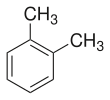| |||
| Names | |||
|---|---|---|---|
| Preferred IUPAC name 1,2-Xylene [1] | |||
| Systematic IUPAC name 1,2-Dimethylbenzene [1] | |||
| Other names o-Xylene, [1] o-Xylol | |||
| Identifiers | |||
3D model (JSmol) | |||
| 1815558 | |||
| ChEBI | |||
| ChEMBL | |||
| ChemSpider | |||
| DrugBank | |||
| ECHA InfoCard | 100.002.203 | ||
| EC Number |
| ||
| 67796 | |||
| KEGG | |||
PubChem CID | |||
| RTECS number |
| ||
| UNII | |||
| UN number | 1307 | ||
CompTox Dashboard (EPA) | |||
| |||
| |||
| Properties | |||
| C8H10 | |||
| Molar mass | 106.168 g·mol−1 | ||
| Appearance | Colorless liquid | ||
| Density | 0.88 g/ml | ||
| Melting point | −24 °C (−11 °F; 249 K) | ||
| Boiling point | 144.4 °C (291.9 °F; 417.5 K) | ||
| 0.02% (20 °C) [2] | |||
| Solubility in ethanol | very soluble | ||
| Solubility in diethyl ether | very soluble | ||
| Vapor pressure | 7 mmHg (20°C) [2] | ||
| −77.78·10−6 cm3/mol | |||
Refractive index (nD) | 1.50545 | ||
| Viscosity | 1.1049 cP at 0 °C 0.8102 cP at 20 °C | ||
| Structure | |||
| 0.64 D [3] | |||
| Hazards | |||
| Occupational safety and health (OHS/OSH): | |||
Main hazards | Mildly toxic | ||
| GHS labelling: | |||
   | |||
| Danger | |||
| H225, H226, H304, H305, H312, H315, H319, H332, H335, H412 | |||
| P210, P233, P240, P241, P242, P243, P261, P264, P271, P273, P280, P301+P310, P302+P352, P303+P361+P353, P304+P312, P304+P340, P305+P351+P338, P312, P321, P322, P331, P332+P313, P337+P313, P362, P363, P370+P378, P403+P233, P403+P235, P405, P501 | |||
| NFPA 704 (fire diamond) | |||
| Flash point | 32 °C (90 °F; 305 K) | ||
| 463 °C (865 °F; 736 K) [4] | |||
| Explosive limits | 0.9%-6.7% [2] | ||
Threshold limit value (TLV) | 100 ppm [4] (TWA), 150 ppm [4] (STEL) | ||
| Lethal dose or concentration (LD, LC): | |||
LD50 (median dose) | 4300 mg/kg (rats, orally) [5] | ||
LCLo (lowest published) | 6125 ppm (rat, 12 hr) 6125 ppm (human, 12 hr) [6] | ||
| NIOSH (US health exposure limits): | |||
PEL (Permissible) | TWA 100 ppm (435 mg/m3) [2] | ||
REL (Recommended) | TWA 100 ppm (435 mg/m3) ST 150 ppm (655 mg/m3) [2] | ||
IDLH (Immediate danger) | 900 ppm [2] | ||
| Safety data sheet (SDS) | External MSDS | ||
| Related compounds | |||
Related aromatic hydrocarbons | m-xylene p-xylene toluene | ||
| Supplementary data page | |||
| O-Xylene (data page) | |||
Except where otherwise noted, data are given for materials in their standard state (at 25 °C [77 °F], 100 kPa). | |||
o-Xylene (ortho-xylene) is an aromatic hydrocarbon with the formula C6H4(CH3)2, with two methyl substituents bonded to adjacent carbon atoms of a benzene ring (the ortho configuration). It is a constitutional isomer of m-xylene and p-xylene, the mixture being called xylene or xylenes. o-Xylene is a colourless slightly oily flammable liquid. [7]


